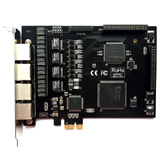

| Index |
|||||||||||
Asterisk FeaturesAmazingly enough, Asterisk has more features than most traditional PBX systems, which are composed of a large box full of hardware. Hence, the Asterisk mantra of 'it's just software'. The following is only a partial list of the many features included with Asterisk: Automated Attendant: An automated system for answering incoming calls and routing them based on the caller's responses to voice prompts. Blacklists: Blacklisting is the ability to easily add numbers to a central database that will prevent calls from the blacklisted phone numbers being processed by the system. Call Detail Records: The detailed call reports and usage statistics to show an administrator the activity of the phone system. Call Forward on Busy: This feature automatically forwards a call to another extension if the called extension is busy. Call Forward on No Answer: This feature automatically forwards a call to another extension if the called extension does not answer. Call Parking: This feature refers to placing a call into a holding state so that it can be picked up at another extension. Call Queuing: A system that allows inbound callers to sit in a holding room listening to music on-hold until the next available agent is available to speak to them. Call Recording: The ability to record inbound or outbound calls to .wav files. Call Routing: Based on the phone number that was dialed (DID) or the number that was called from (ANI), a call can be routed to a specified extension, group, queue, etc. Call Transfer: This refers to the ability to transfer an existing call to another extension. Caller-ID: Caller-ID is used to display the phone number and other available information of the user that is calling into the system. Conference Bridging: Asterisk has the ability to create conference rooms that multiple people can attend at one time for group meetings. Interactive Directory Listing: A Company directory system that can look up users by first or last name. Interactive Voice Response (IVR): This system uses pre-recorded voice menus to prompt callers to make selections via their phone such as "press 1 for sales, 2 for support". Music On-Hold: Asterisk can play MP3 files to callers who are on-hold or waiting in a queue. Remote Office Support: Asterisk uses Internet Protocols for communication. Hence, users can be at remote locations and have access to the system via broadband Internet connection. VoIP Gateways: Using the new Internet Telephone Service Providers (ITSPs), an Asterisk system can have telephone network connectivity without having to use a normal analog service provider. Voicemail: Each user in an Asterisk system can have their extension and voicemail account. Using Issabel FreePBX, the voicemail can be retrieved via their phone, from a remote location, sent via email, or accessed via a web browser. At the time of writing, Asterisk was at version 1.2 branch. Some of the new features in this version include: A new dynamic IVR (Interactive Voice Response) flow-control interface PRI improvement SIP support improvements Customized CDR (Call Detail Record) support A real-time database configuration storage engine A new real-time interface that allows for faster and less disruptive configuration changes New dial plan syntax and a new dial plan language, including many new applications and dial plan functions Improvements in protocol handling for better voice quality
-ISDN BRI and ISDN PRI Services |




